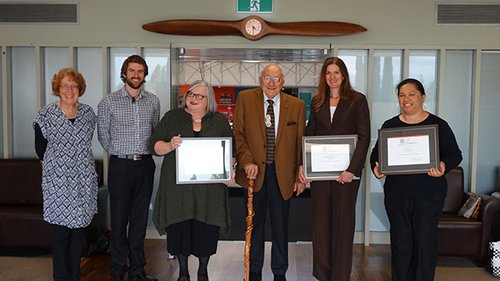
The New Zealand Oral History 1946-1948 collection, recorded by the New Zealand Broadcasting Service’s Mobile Unit, was inscribed on the UNESCO Memory of the World New Zealand Register of Documentary Heritage at a ceremony in Christchurch yesterday. A number of our Christchurch-based staff were excited to be there for the festivities.
The recordings include accounts of New Zealand life as far back as the 1850s. The collection is now cared for by our sound archiving team in Christchurch.

In this photo are representatives from the three organisations (Auckland Museum, Hocken Library, and The New Zealand Oral History 1946-1948 collection receiving their awards. The central figure is Sir Tipene O’Regan.
Sir Tipene O’Regan, chairman of the Ngāi Tahu Māori Trust Board, was guest speaker at the inscription ceremony. He explained how the Mobile Unit recordings, such as those made in 1948 of the Karitane Māori choir, evoke powerful memories of whānau and iwi connections.

Presentation on the New Zealand Oral History 1946-1948 collection at the inscription ceremony.
Among other memories recalled in the recordings are: the Taranaki Wars, the early days of the frozen meat trade, the first thistle and first rabbits seen in Otago, the Chinese miners’ use of opium, the first bicycle – which frightened horses – and the coming of electric power.

The certificate of inscription.
In this recording from the collection Mrs Fullarton, who was interviewed in Port Chalmers in 1948, recalls the impractical fashions of her childhood in the 1860s:
[Archival audio from the Ngā Taonga Sound & Vision collection. Any re-use of this audio is a breach of Copyright. To request a copy of the recording, contact us.
In the clip below, CTV – Canterbury Television – visits the Ngā Taonga Sound & Vision Christchurch branch. They speak to staff Karen Neill and John Kelcher, who play one of the discs in the collection for them.
Hero image: Karen Neill (Head of Partnerships, Ngā Taonga Sound & Vision) speaks at the ceremony for the inscription. Ceremony images by Marie O’Connell.